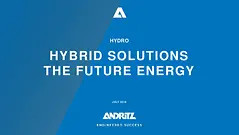ANDRITZ HYDRO GmbH
HyBaTec
Hybrid battery solution for hydropower by ANDRITZ Hydro
Hydropower is the most proven and best-developed form of renewable electricity generation. Especially low head hydropower plants are facing some challenges like water level, reservoir restrictions, base load etc. HyBaTec is a dedicated hybrid solution for the hydropower industry, combining a Turbine-Generator-Unit with a battery. It can be added to all type of turbines. The battery will be integrated in the electrical power plant and in the control system to extend the lifetime and to optimize the revenue of the power plant.
Benefits at a glimpse
- Extension of lifetime by reducing mechanical stresses (Lifetime)
- Additional opportunities for energy market participation (Grid)
- Flexible energy storage and shift over the day (Storage)
- Up to 25% extension of operation range
- Fitting for existing as well as "greenfield" hydropower plant


HyBaTec extends the operation range compared to a conventional hydro application depending on the size of the battery up to +/- 25 %.
In addition to the run of river operation mode, new operation modes and services to the grid are possible. Faster response times and very flexible operation due to the interaction of the TG Unit and the battery will be possible without restrictions due to electrical, mechanical and hydraulic restrictions.
The battery compensates weaknesses of the Turbine-Generator unit in case of part load and in case load changes during operation. The hydropower plant consisting of a Turbine-Generator Unit and a battery is considered as one technical unit delivering energy or services to the grid.
The ANDRITZ Station controller, which is the master of the system, considers requirements arriving from the grid, technical/physical restrictions of the battery and the Turbine-Generator Unit, and particularizes of the hydrological situation of the respective power plant. It manages the battery load condition depending on the intended operation mode.

The main components of the HyBaTec system are:
- Andritz Station Controller (ASC) including Energy Management System (EMS)
- Battery (Converter, BMS, Fire Protection)
- Temperature management
- Container (if necessary)
- Electrical integration of the battery in the EPS system
- Installation and commissioning
- Trial operation
The scale of the battery reaches from 100 kWh up to 10 MWh. The battery can be either installed in a container - in order to be mobile and be able to use the container with the battery for different applications - or can be integrated in cubicles directly in the hydropower power plant.
Following different application potentials and use cases for the new HyBaTec system are illustrated:
Lifetime mode
Most of the low-head units (Bulb and Kaplan Turbines) are operating in frequency control to stabilize and balancing the grid frequency. HyBaTec is used for smoothing small frequency fluctuations between +/- 0.1 % in the grid by delivering or consuming power for short times. The need for this service in the grid is increasing steadily. This causes a dramatically reduction of the movements of the servomotors which will lead to an extended lifetime and to reduced maintenance cost and prolonged maintenance intervals. The service helps to stabilize the grid and gives essential cost savings to the operator.
Grid mode
The main target is to contribute to the primary and secondary energy market. HyBaTec enables to participate with the power plant very flexible to the service market. The primary market potential of the turbine can be enhanced by the battery. For the primary control market the battery can be used for delivering very fast additional guaranteed power to the grid in case of need. In case of secondary control the battery can be used to respond very fast upon grid request and the turbine can be started slowly from stand still and must not be operated as usual at very low part load which is disadvantageous to the lifetime of the turbine due to pressure pulsations and fluctuations.
Storage mode
The main target is to increase the revenue of low-head hydropower plants by partly shifting energy over the day. Basically the system creates a limited storage capacity not comparable to pump turbines, but makes it acting like them.
Compensate hydrologic limitations
If the operation flexibility of the turbine is restricted by hydrological limitations (less water in some times of the year, mandatory residual flow can be used for power production, sensitive water passage, etc.) a battery can help to ensure the flexibility the operator wants to have.
Island operation
In case of island operation a battery can help to stabilize the grid and can be used as black start capacity. Danger of outages can be reduced to a minimum. Also the lifetime due to much less movements of the governor system can be increased essential.
Black start capability
General in addition to other advantages a battery can be used as black start equipment and diesel generators are not needed anymore.
Self consumption demand
Batteries can be used to cover the self consumption demand of the power plant. Batteries can be charged in case of low tariff periods behind the meter. This energy can be used also for other applications, e.g. charge cars.Batteries can be used to increase or keep the flexibility with regards to the European “Wasserrahmenrichtlinie”.
Batteries can be used to increase or keep the flexibility with regards to the European “European Water Framework Directive”.
Future Sunk and swall restrictions which lead to restrictions in the operational flexibility of a hydro power plant can be compensated by a battery. No or reduced storage basins are necessary in order to keep the same flexibility of hydro power plants in the future.



